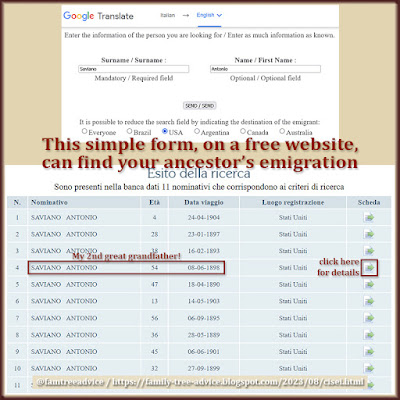I've just finished the second of my most ambitious genealogy research projects. I created inventories of available vital records from my ancestral hometowns. Then I reviewed each document, placing about 95% of the people into my family tree.
First I did my Grandpa Iamarino's town of Colle Sannita. Now I've wrapped up my Grandpa Leone's neighboring town of Baselice. I've shared 5 inventory spreadsheets on my www.forthecousins.com website. And I'll have another town ready soon (Circello).
 |
| No matter how distant the relationship, there's value to every connection in your ancestral hometown. |
The reason 95% of the people from the documents can fit in my family tree is that the towns are remote. They were even more isolated before automobiles. Everyone in town was likely to marry a neighbor. The 5% of people I can't fit into my tree are:
- out-of-towners or
- members of noble families who married other aristocrats.
Why Spend All That Time?
The benefits of this time-consuming project include:
- Gaining familiarity with all the last names in town.
- Overcoming bad handwriting because of that familiarity.
- Finding connections to DNA matches because their people are in your tree.
- Knowing exactly who everyone in town was and their relationship to you.
The first step in such a project is making your inventory. View the town's documents online (find Italian vital records on Antenati or FamilySearch). Then make a brief entry in a spreadsheet for each image. My preferred format is: document number name of subject "di" father's name. (The word "di" is Italian for of, and that's how these documents denote the father's name: di Giovanni, di Antonio, etc.)
An example is: 82 Adamo Leone di Giovanni & 83 Antonia Maria Colucci di Leonardo. That's a single document image showing 2 birth records. Document #82 is my grandfather's 1891 birth record. He is the subject of the document and his father is Giovanni. Also in the image is document #83 for Antonia Maria Colucci, daughter of Leonardo.
The towns of Colle Sannita and Baselice each had under 3,000 inhabitants in he 1800s. The vital records have added at least 30,000 people to my family tree. I have a complete inventory for the town of Pesco Sannita ready and waiting for my review. I'll go through the same process with Pesco as I did for Colle and Baselice:
- View each vital record to see if the subject, their parents, or their spouse are already in my family tree.
- When I can find where this person fits, add the facts from the document, including dates, places, and the names of family members.
- If I can't find a place for this person in my tree, I highlight that line in the spreadsheet in yellow. It's very possible that their connection will show up after I review more documents. I'll make a second pass through the spreadsheet later to see if they can fit.
I've listed the benefits of this project and explained my process. But you may still be wondering why it's worth such a huge commitment of time. Three reasons spring to mind:
- Connection. Familiarity with the people from my hometowns gives me a strong connection to these places. They aren't merely the quaint and beautiful towns I've visited a few times. They are me! I love knowing how deep my roots go in each town.
- Knowledge. Often I see people on Facebook asking how they can learn more about their ancestors' day-to-day lives. If you come from a remote town and you're not descended from nobility, you're not going to find their journal tucked away in some archive. They were likely illiterate and living a life of hard work. You may find some general writings about life in that area at a certain time. A history of your ancestral town may provide those types of clues. Otherwise, all you can learn about your ancestor is that they came from this family, married this person, had this job, had these children, and died. Those family names and dates are what you can discover in the town's vital records.
- DNA Matches. Because I've studied my ancestral hometowns' documents, I can quickly recognize my entry point into a DNA match's family tree. If you're only looking at a match's tree for your last name, you're missing out on that entry point.
The title of this article mentions a half 4th cousin once removed. I chose someone from my family tree randomly. This cousin is a descendant of my 4th great grandfather Gennaro Pilla and his second wife. Gennaro had 2 children with my 4th great grandmother, and 5 children with his 2nd wife. That's 5 threads I'd have missed if I paid attention only to my direct line. And this particular half 4C1R led me to his son, my half 5th cousin John, who introduced me to a ton of relatives in Canada. I met lots of people with my maiden name on that trip to Canada. That's a rarity.
I love being able to encompass entire towns with my family tree. If you're staying on the straight-and-narrow, gathering information about your direct ancestors only, you're missing out on so many connections!







